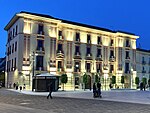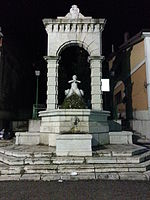Avellino Cathedral
11th-century establishments in Italy19th-century Roman Catholic church buildings in ItalyAvellinoBaroque church buildings in CampaniaCathedrals in Campania ... and 5 more
Churches in the province of AvellinoNeoclassical architecture in CampaniaNeoclassical church buildings in ItalyRoman Catholic cathedrals in ItalyRoman Catholic churches completed in 1868

Avellino Cathedral (Italian: Duomo di Santa Maria Assunta e di San Modestino, Cattedrale di Avellino) is a Roman Catholic cathedral dedicated to the Assumption of the Virgin Mary and Saint Modestinus in Avellino, Campania, Italy. It is the seat of the bishops of Avellino.
Excerpt from the Wikipedia article Avellino Cathedral (License: CC BY-SA 3.0, Authors, Images).Avellino Cathedral
Via Sette Dolori, Avellino
Geographical coordinates (GPS) Address External links Nearby Places Show on map
Geographical coordinates (GPS)
| Latitude | Longitude |
|---|---|
| N 40.9153 ° | E 14.797 ° |
Address
Cattedrale di Avellino
Via Sette Dolori
83100 Avellino
Campania, Italy
Open on Google Maps










